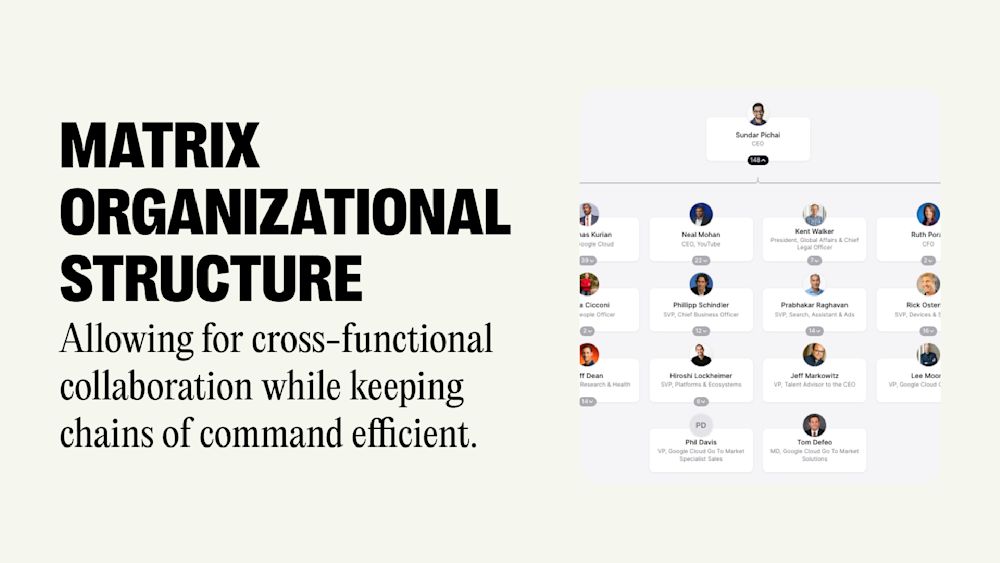Table of contents
Many larger companies operate with organizational structures that don’t always fit into traditional hierarchies. However, many companies also find that flat organizational structures have their challenges. That’s where matrixed organizations come in.

Matrix organizational structures incorporate elements from both traditional and modern designs to allow for cross-functional collaboration while keeping chains of command efficient. For many, this has proven to be an effective model — but like any other, it also comes with certain challenges.
Read on to learn more about what matrixed organizational structures are and how one of the world’s technology leaders uses them to great effect.
What is a matrix organizational structure?
A matrix organizational structure is a model that draws on elements from flat and traditional organizational structures. In a matrixed organization, employees report to both their functional manager in the vertical structure and a project manager in the horizontal structure.
As employees report to both a functional lead and a project manager, matrix management enhances collaboration to distribute knowledge across departments like in flat organizational structures while simultaneously maintaining the clear chain of command found in traditional hierarchies.
Pros and cons of a matrix organizational structure
Many experts in organizational management agree that vertical organizational structures are old-fashioned in today’s modern society. The antidote to the traditional hierarchy is the flat organizational structure. However, this model can sometimes prove to be _too _flexible.
The matrix organizational structure seeks to incorporate the best of the two into one. As with any other organizational structure, there are both advantages and disadvantages of a matrix-style structure.
Advantages of matrixed organizational structures
Better communication
Within a matrix organizational structure, communication flows both horizontally across teams with different skills and vertically through the functional hierarchy. The ability to communicate with functional leaders as well as cross-functional project leads can allow for better communication.
Development of skills
In traditional, vertical organizational structures, employees work within their specific area of expertise. With cross-functional matrix management, teams are interconnected, allowing knowledge to flow between them. For example, an employee working within marketing can learn more about the company’s product from the engineering team.
Dual-perspective problem-solving
With the aforementioned example in mind, a matrixed organization enables problems to be solved with a more holistic approach. Traditionally, the engineering team would be “isolated” from marketing-related knowledge, yet this knowledge may be useful in solving a problem within their work.
As employees report to both the functional lead and the project lead in a matrix organizational structure, knowledge is distributed cross-functionally to illuminate the problem from several perspectives. Bringing skills from different teams together can lead to innovative solutions.
Disadvantages of matrix organizational structures
Time consumption
While the duality of a matrix-style organizational structure has benefits, it can also lead to more time-consuming workflows. Cross-functional integration of teams, dual reporting, and additional meetings can lead to more time spent talking and less time spent working.
Delayed decisions
Matrixed organizations make teams more connected, but can also slow the decision-making process. This happens because communication and coordination between teams increase, involving more employees and decision-makers and complexifying the process.
Power struggles
As we have learned, employees report vertically and horizontally to functional and project managers in a matrix organizational structure. This results in two managers with different goals that have to be aligned in order to make a decision. If the two are not aligned, this can result in internal power struggles with a wide range of negative consequences.
Example of a matrix organizational structure
An example of a company with a cross-functional matrix management style is Google. Drawing on elements from flat organizational structures, employees work in teams. There’s a limited layer of middle management, and employees enjoy a high level of autonomy.
While Google’s organizational structure has flat characteristics, it also incorporates traditional hierarchical elements; teams belong to functional departments, and employees have a clear chain of command.
With team-based cross-functional collaboration, employee autonomy, and management through traditional chains of command, Google has leveraged the best of two worlds to build an efficient organizational structure.
Google’s position as a leader in its field coupled with a high employee satisfaction score is evidence that the technology giant has succeeded in navigating the challenges that can arise when adopting a matrix-style organizational structure.
Learn more about organizational design
Want to learn more about organizational structures? At The Org, we have the world’s largest network of publicly available org charts and a ton of resources that will teach you more about management, organizational design, and how you can make your own org chart.


The ORG helps
you hire great
candidates
Free to use – try today